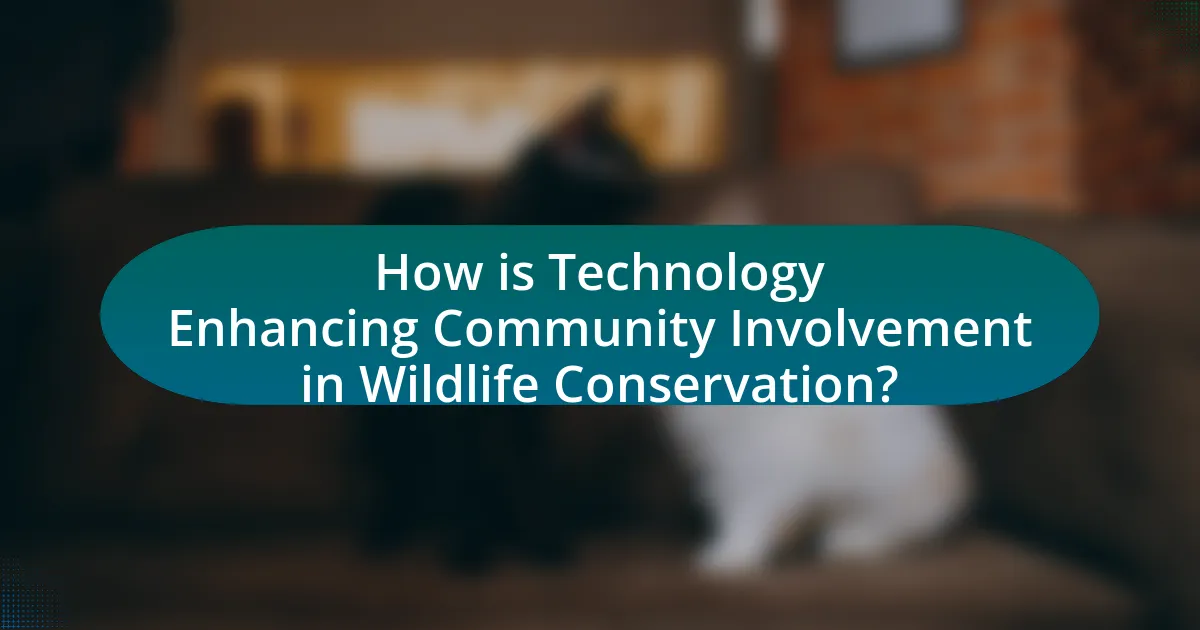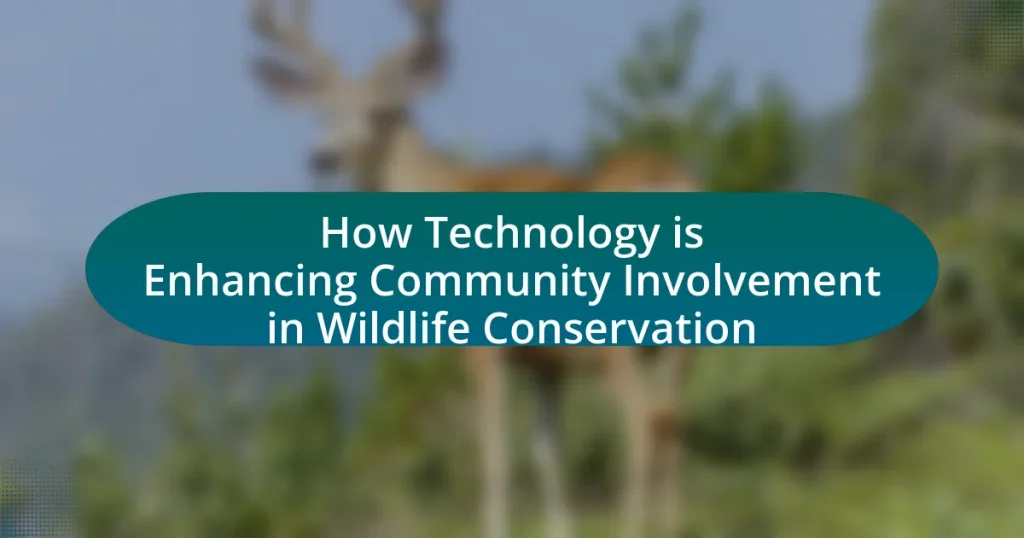The article focuses on how technology is enhancing community involvement in wildlife conservation. It highlights the role of mobile applications, social media, and remote sensing technologies in facilitating real-time data sharing and engagement among local communities. Key topics include the importance of community participation in conservation efforts, the use of innovative tools for tracking wildlife populations, and the social benefits of local stewardship. Additionally, the article addresses challenges in integrating technology with community involvement and outlines best practices for sustainable technology use in conservation initiatives.

How is Technology Enhancing Community Involvement in Wildlife Conservation?
Technology is enhancing community involvement in wildlife conservation by facilitating real-time data sharing and engagement through mobile applications and social media platforms. These tools enable local communities to report wildlife sightings, track poaching activities, and participate in conservation initiatives, thereby increasing awareness and fostering a sense of responsibility. For instance, platforms like iNaturalist allow users to document biodiversity, contributing valuable data to conservation efforts. Additionally, drones and remote sensing technologies provide communities with access to critical information about wildlife habitats, enabling them to take proactive measures in conservation. This integration of technology not only empowers communities but also leads to more effective conservation strategies, as evidenced by increased participation rates in conservation programs where technology is utilized.
What role does technology play in wildlife conservation efforts?
Technology plays a crucial role in wildlife conservation efforts by enabling data collection, monitoring, and analysis to protect endangered species and their habitats. For instance, satellite imagery and drones facilitate the tracking of wildlife movements and habitat changes, allowing conservationists to respond quickly to threats such as poaching or habitat destruction. Additionally, mobile applications empower local communities to report wildlife sightings and illegal activities, fostering greater community involvement in conservation initiatives. Research indicates that the use of camera traps has increased the efficiency of wildlife monitoring, providing valuable data on species populations and behaviors, which is essential for informed conservation strategies.
How do mobile applications facilitate community engagement in conservation?
Mobile applications facilitate community engagement in conservation by providing platforms for information sharing, participation in conservation activities, and fostering collaboration among users. These applications enable users to report wildlife sightings, track conservation efforts, and access educational resources, thereby increasing awareness and involvement in local conservation initiatives. For instance, apps like iNaturalist allow users to document biodiversity, contributing valuable data to scientific research while encouraging community members to engage with their environment. Additionally, mobile applications often include features for organizing events, such as clean-up drives or wildlife monitoring, which further mobilizes community action and strengthens collective efforts in conservation.
What technologies are used for tracking wildlife populations?
Technologies used for tracking wildlife populations include GPS collars, camera traps, and acoustic monitoring devices. GPS collars provide real-time location data, allowing researchers to monitor animal movements and behaviors over time. Camera traps capture images of wildlife, enabling population estimates and behavioral studies without human presence. Acoustic monitoring devices record sounds in the environment, helping to track species that are difficult to observe visually. These technologies enhance data collection and analysis, contributing to more effective wildlife conservation efforts.
Why is community involvement crucial for wildlife conservation?
Community involvement is crucial for wildlife conservation because it fosters local stewardship and enhances the effectiveness of conservation efforts. Engaging communities leads to increased awareness and education about local wildlife and ecosystems, which can result in more sustainable practices. For instance, studies have shown that when local populations participate in conservation initiatives, such as habitat restoration or anti-poaching efforts, the success rates of these projects improve significantly. A report by the World Wildlife Fund indicates that community-led conservation areas have seen a 50% increase in biodiversity compared to areas without such involvement. This demonstrates that local engagement not only empowers communities but also directly contributes to the preservation of wildlife.
How does local knowledge contribute to effective conservation strategies?
Local knowledge significantly enhances effective conservation strategies by providing insights into local ecosystems, species behavior, and community practices. This knowledge allows conservationists to tailor strategies that are culturally relevant and ecologically sound, leading to better outcomes. For instance, studies have shown that integrating local ecological knowledge with scientific research can improve biodiversity management, as seen in the work of Berkes et al. (2000), which highlights the importance of traditional ecological knowledge in sustainable resource management. By leveraging local expertise, conservation efforts can become more adaptive and responsive to the specific needs of the environment and the community, ultimately fostering greater participation and commitment to conservation initiatives.
What are the social benefits of community participation in conservation?
Community participation in conservation fosters social cohesion and enhances local stewardship of natural resources. Engaging communities in conservation efforts leads to increased awareness and education about environmental issues, which strengthens community ties and promotes collective action. Research indicates that when communities actively participate, they are more likely to develop a sense of ownership over local ecosystems, resulting in sustainable practices that benefit both the environment and the community. For example, a study published in the journal “Conservation Biology” found that community-led conservation initiatives significantly improved local biodiversity and increased community resilience against environmental changes.
What are the challenges faced in integrating technology with community involvement?
Integrating technology with community involvement in wildlife conservation faces several challenges, including digital divide issues, resistance to change, and varying levels of technological literacy among community members. The digital divide creates disparities in access to technology, limiting participation from marginalized groups. Resistance to change often stems from traditional practices and skepticism about new methods, hindering the adoption of technological solutions. Additionally, differing levels of technological literacy can lead to misunderstandings or misuse of technology, which can undermine conservation efforts. These challenges highlight the need for tailored approaches that consider community needs and capacities to effectively integrate technology into conservation initiatives.
How can technology bridge the gap between conservationists and local communities?
Technology can bridge the gap between conservationists and local communities by facilitating communication, enhancing data sharing, and promoting collaborative conservation efforts. For instance, mobile applications enable local communities to report wildlife sightings and poaching incidents in real-time, which helps conservationists respond quickly and effectively. Additionally, platforms like social media allow conservationists to engage with local populations, raising awareness and fostering a sense of ownership over conservation initiatives. Research shows that community-based conservation projects that utilize technology, such as GPS tracking and remote sensing, have led to increased participation and improved outcomes in biodiversity preservation.
What barriers exist in adopting technology for wildlife conservation?
Barriers in adopting technology for wildlife conservation include high costs, lack of technical expertise, and insufficient infrastructure. High costs can deter organizations from investing in advanced technologies, as many conservation projects operate on limited budgets. Additionally, a lack of technical expertise among conservationists can hinder the effective implementation and use of technology, as specialized training is often required. Furthermore, insufficient infrastructure, particularly in remote areas, can limit access to necessary tools and resources, making it challenging to deploy technology effectively. These barriers collectively impede the integration of innovative solutions that could enhance wildlife conservation efforts.
How can technology be leveraged to improve conservation outcomes?
Technology can be leveraged to improve conservation outcomes by utilizing data analytics, remote sensing, and community engagement platforms. Data analytics enables the analysis of large datasets to identify trends and inform decision-making, while remote sensing technologies, such as satellite imagery and drones, provide real-time monitoring of ecosystems and wildlife populations. For instance, a study published in the journal “Conservation Biology” highlights how satellite data has been used to track deforestation rates, allowing for timely interventions. Additionally, community engagement platforms facilitate collaboration between local communities and conservation organizations, enhancing participation and awareness. The integration of these technologies has been shown to increase the effectiveness of conservation strategies, as evidenced by successful wildlife monitoring programs that utilize mobile applications for reporting sightings and threats.
What innovative tools are being developed for community-led conservation projects?
Innovative tools being developed for community-led conservation projects include mobile applications, remote sensing technologies, and participatory mapping platforms. Mobile applications enable local communities to report wildlife sightings, track poaching incidents, and share conservation data in real-time, enhancing community engagement and data collection. Remote sensing technologies, such as drones and satellite imagery, provide critical information on habitat changes and biodiversity, allowing communities to monitor their environments effectively. Participatory mapping platforms empower local stakeholders to visualize and manage their natural resources collaboratively, fostering a sense of ownership and responsibility. These tools collectively enhance the capacity of communities to actively participate in conservation efforts, supported by evidence from various case studies demonstrating increased local involvement and improved conservation outcomes.
How can data analytics enhance decision-making in wildlife conservation?
Data analytics enhances decision-making in wildlife conservation by providing actionable insights derived from large datasets, enabling more effective resource allocation and strategy development. For instance, analytics can identify patterns in animal migration, population dynamics, and habitat use, which helps conservationists prioritize areas for protection or restoration. A study by the World Wildlife Fund found that using data analytics improved the efficiency of anti-poaching efforts by 30%, demonstrating its impact on real-world conservation outcomes. By leveraging data from satellite imagery, GPS tracking, and citizen science, wildlife managers can make informed decisions that lead to better conservation practices and community engagement.
What best practices can communities adopt to effectively use technology in wildlife conservation?
Communities can effectively use technology in wildlife conservation by implementing data collection and monitoring systems, utilizing mobile applications for reporting wildlife sightings, and engaging in community-based conservation platforms. Data collection systems, such as camera traps and GPS tracking, allow for real-time monitoring of wildlife populations and habitats, which has been shown to improve conservation outcomes by providing critical information for decision-making. Mobile applications enable community members to report sightings and poaching incidents, fostering a sense of responsibility and involvement, as evidenced by the success of apps like iNaturalist, which has over 1.5 million users contributing to biodiversity data. Additionally, community-based platforms, such as social media groups, facilitate knowledge sharing and collaboration among stakeholders, enhancing community engagement and awareness of conservation issues.
How can communities ensure sustainable use of technology in conservation efforts?
Communities can ensure sustainable use of technology in conservation efforts by implementing participatory approaches that involve local stakeholders in decision-making processes. Engaging community members in the design and application of technology fosters ownership and accountability, which are crucial for long-term sustainability. For instance, the use of mobile applications for wildlife monitoring has been successful when local residents are trained to use these tools, as seen in projects like the Wildlife Conservation Society’s initiatives in Africa, where local involvement led to increased data accuracy and commitment to conservation goals. This collaborative model not only enhances the effectiveness of conservation efforts but also builds local capacity and resilience against environmental challenges.
What resources are available for communities to learn about technology in conservation?
Communities can access various resources to learn about technology in conservation, including online courses, workshops, and community programs. For instance, platforms like Coursera and edX offer courses on conservation technology, while organizations such as the World Wildlife Fund and Conservation International provide workshops and training sessions focused on the application of technology in conservation efforts. Additionally, local universities often collaborate with conservation groups to host seminars and informational sessions, enhancing community engagement and knowledge in this field.


